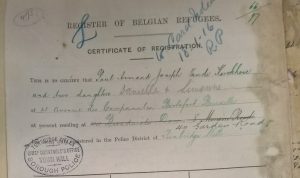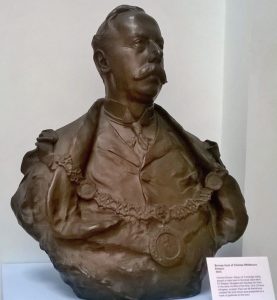“A souvenir of the Belgians’ friendship and visit to the town”
In 1915 the Belgian Community of Tunbridge Wells commissioned Belgian sculptor Paul Vd Kerckhove, himself a refugee, to make a bust of the town’s Mayor and Chairman of the Borough Belgian Refugees’ Committee, Cllr Charles Whitbourn Emson. The sculptor undertook the work free of charge, and local artist, Alexander Kirk, made his studio on Cumberland Walk available to him. According to the Courier newspaper of 23rd July 1915, while in Tunbridge Wells M. Vd Kerckhove took the opportunity to mould a number of busts of local people.

Paul Vd Kerckhove (1876-??), from Boitsfort near Brussels, was a well-known Belgian artist, from a family of well-known artists. After consulting Census records in Brussels, I believe he was the son of sculptor J. Antoine Van De Kerckhove “dit NELSON” (c1849-?) but I have yet to prove it… A member of the Civic Guard in Brussels, he had been forced to flee in September 1914. At some point his wife and their two daughters joined him, and they were all together in Tunbridge Wells from February 1915, first at Broadwater Court, then at 8 Monson Road, and finally at 40 Garden Road.

Once the Bust was finished, the family returned to London where Paul stayed while his wife and daughter went north to Blackpool. He lived for a while with foundry owner Ercole Parlanti and is known to have exhibited at the Royal Academy in 1917 and 1918, one of his subjects being Parlanti’s daughter Olga.

Royal Academy Catalogue extract courtesy of Steve Parlanti
The bust of Mayor Emson was presented to the town of Tunbridge Wells on 22nd September 1915 with great pomp and ceremony at the Great Hall by President of the Club Albert, Professor Joseph Willems, and at the same time an illustrated album, no doubt similar to the one offered a year later to Amelia and Louisa Scott, was presented to the Mayor by M. Ernst Kumps. There were speeches and then a concert at which leading Belgian artistes performed, not least M. Jean Delville, himself a refugee in London, who recited “several of his dramatic and patriotic poems” (Kent & Sussex Courier 25 September 1915). (1)
In his acceptance speech, Mayor Emson stated that the sculpture would be placed in the Town Hall as a “perpetual memorial of the joint struggle of [our] nations” and would “ever remain as a souvenir of the Belgians’ friendship and visit to the town”. (2)

Paul Vd Kerckhove’s bronze bust of Mayor Whitbourn Emson (Photo Alison MacKenzie 2016)
______________________
(1) The Bust featured in the book Belgian Art in Exile which was published in January 1916 by La Ligue des Artistes belges, of which M. Delville was President, to raise money for Belgian charities in England. The Daily Sketch wrote ‘Belgian Art in Exile is the title of a very attractive album of reproductions, mostly in colour, of paintings by exiled Belgian artists, with photographs of works by Belgian sculptors, which has been issued in aid of the Belgian Red Cross and other Belgian charitable institutions. The colour-plates… show the high quality and great versatility of modern Belgian art’.
(2) It stands in the lobby of the Council Chamber and is viewable once a year during Heritage Open Days in September.
Sources
Kent & Sussex Courier (British Newspaper Archive)
Census records, Brussels City Museum
Refugee Registration documents, National Archives, Brussels
Steve Parlanti
Rodney Hall, grandson of Paul Vd Kerckhove
